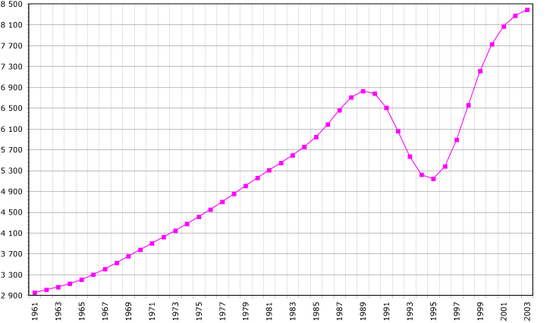Demographics of Rwanda
2007 Schools Wikipedia Selection. Related subjects: African Geography
Rwanda's population density, even after the 1994 genocide, is among the highest in Sub-Saharan Africa at 230/km² (590/mi²). This country has few villages, and nearly every family lives in a self-contained compound on a hillside. The urban concentrations are grouped around administrative centers. The indigenous population consists of three ethnic groups. The Hutus, who comprise the majority of the population (85%), are farmers of Bantu origin. The Tutsis (14%) are a pastoral people who arrived in the area in the 15th century. Until 1959, they formed the dominant caste under a feudal system based on cattleholding. The Twa ( pygmies) (1%) are thought to be the remnants of the earliest settlers of the region. Over half of the adult population is literate, but no more than 5% have received secondary education. During 1994-95, most primary schools and more than half of prewar secondary schools reopened. The national university in Butare reopened in April 1995; enrollment is over 7,000. Rebuilding the educational system continues to be a high priority of the Rwandan Government.
Population: 8,648,248
note: estimates for this country explicitly take into account the effects of excess mortality due to AIDS. This disease can result in lower life expectancy, population, and growth rates; higher infant mortality and death rates; and changes in the distribution of population by age and sex than would otherwise be expected (July 2006 est.)
Age structure:
0-14 years: 41.9% (male 1,558,730; female 1,548,175)
15-64 years: 55.6% (male 1,943,268; female 1,971,542)
65 years and over: 2.5% (male 83,699; female 123,715) (2006 est.)
Population growth rate: 2.43% (2006 est.)
Birth rate: 40.37 births/1,000 population (2006 est.)
Death rate: 16.09 deaths/1,000 population (2006 est.)
Net migration rate: 0 migrant(s)/1,000 population (2006 est.)
Sex ratio:
at birth: 1.03 male(s)/female
under 15 years: 1.01 male(s)/female
15-64 years: 0.99 male(s)/female
65 years and over: 0.67 male(s)/female
total population: 0.99 male(s)/female (2006 est.)
Infant mortality rate: 89.61 deaths/1,000 live births (2006 est.)
male: 94.71 deaths/1,000 live births
female: 84.34 deaths/1,000 live births (2006 est.)
Life expectancy at birth:
total population: 47.3 years
male: 46.26 years
female: 48.38 years (2006 est.)
Total fertility rate: 5.43 children born/woman (2006 est.)
Nationality:
noun: Rwandan(s)
adjective: Rwandan
Ethnic groups: Hutu 84%, Tutsi 15%, Twa (Pygmoid) 1%, 16,000 South Asians (mostly Indians) Arabs 9,300, French 2,500, British 300, Belgian 100
Religions: Roman Catholic 56.5%, Protestant 26%, Adventist 11.1%, Muslim 4.6%, indigenous beliefs 0.1%, none 1.7% (2001)
Languages: Kinyarwanda (official) universal Bantu vernacular, French (official), English (official), Kiswahili (Swahili) used in commercial centers
Literacy:
definition: age 15 and over can read and write
total population: 70.4%
male: 76.3%
female: 64.7% (2003 est.)
- See also : Rwanda
Algeria • Angola • Benin • Botswana • Burkina Faso • Burundi • Cameroon • Cape Verde • Central African Republic • Chad • Comoros • Democratic Republic of the Congo • Republic of the Congo • Côte d'Ivoire (Ivory Coast) • Djibouti • Egypt • Equatorial Guinea • Eritrea • Ethiopia • Gabon • The Gambia • Ghana • Guinea • Guinea-Bissau • Kenya • Lesotho • Liberia • Libya • Madagascar • Malawi • Mali • Mauritania • Mauritius • Morocco • Mozambique • Namibia • Niger • Nigeria • Rwanda • São Tomé and Príncipe • Senegal • Seychelles • Sierra Leone • Somalia • South Africa • Sudan • Swaziland • Tanzania • Togo • Tunisia • Uganda • Western Sahara (Sahrawi Arab Democratic Republic) • Zambia • Zimbabwe
Dependencies and other territories
British Indian Ocean Territory • Canary Islands • Ceuta • Melilla • Madeira Islands • Mayotte • Réunion • St. Helena
